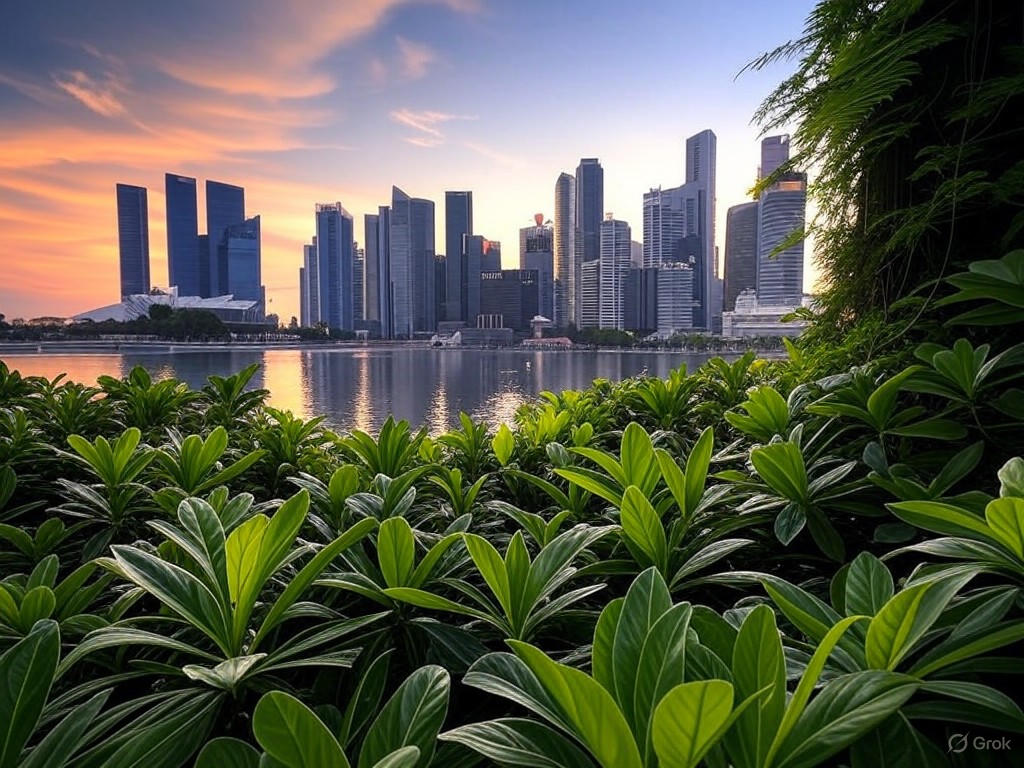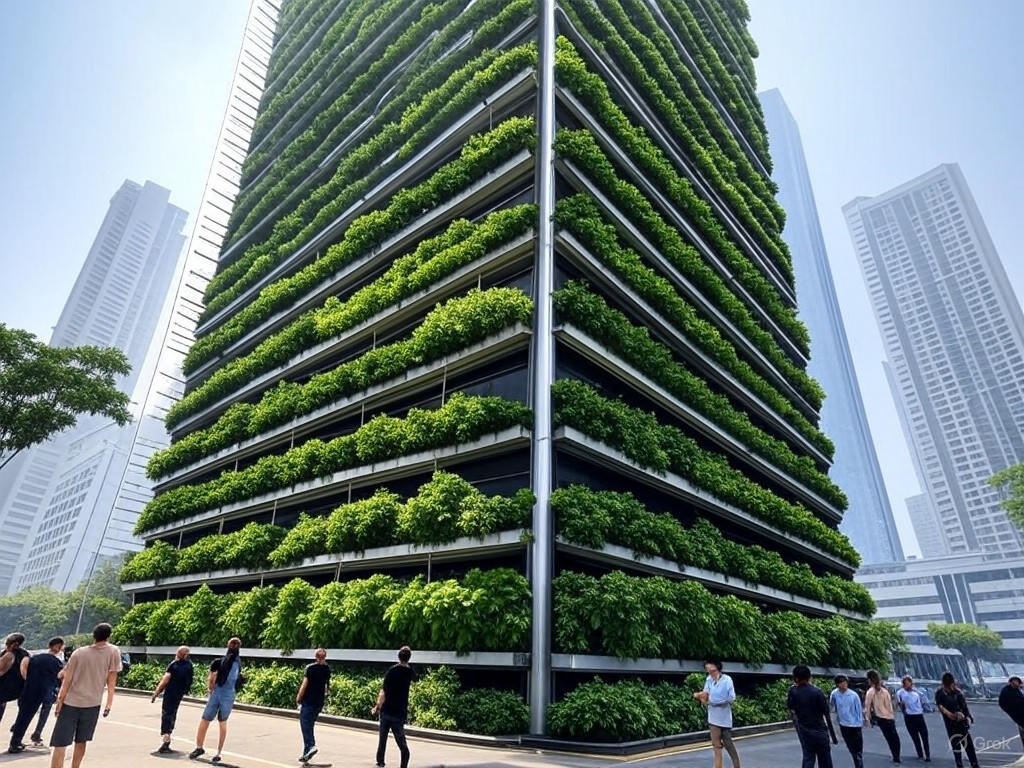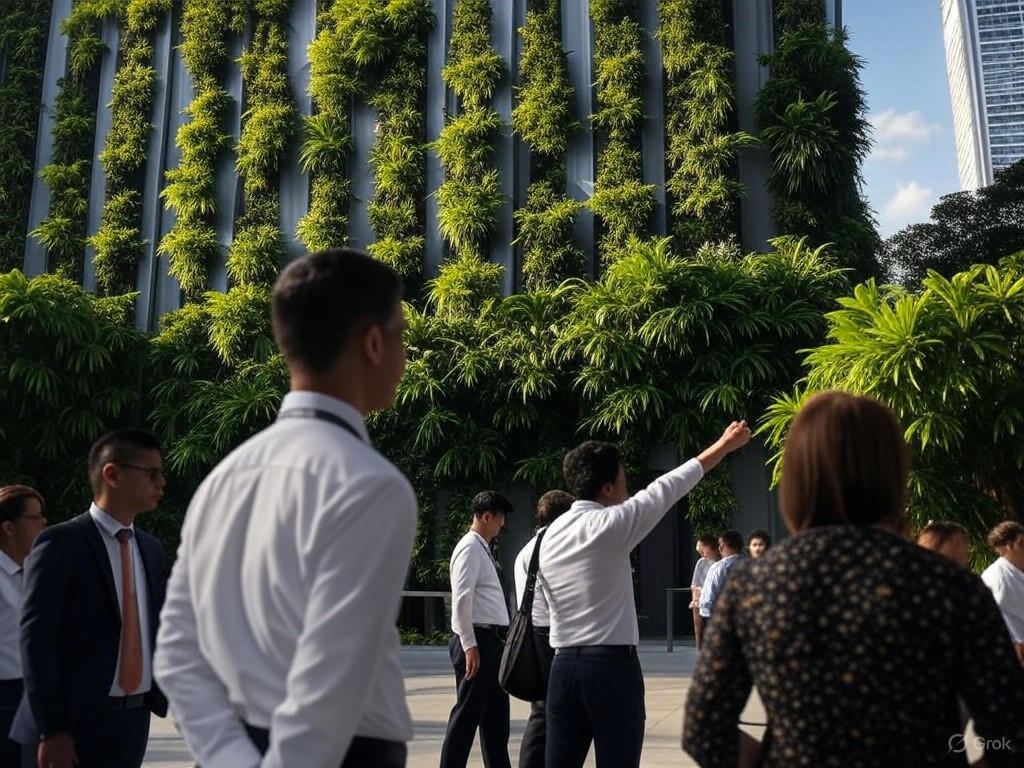Vertical Gardens in Singapore: Greening Urban Spaces
In the sweltering heart of Southeast Asia, where concrete towers pierce the sky and the mercury routinely flirts with uncomfortable heights, Singapore has crafted an unlikely hero: the vertical garden. Picture this—a city-state so densely packed that every square foot is a premium asset, yet it’s transforming its walls and rooftops into lush, green tapestries. It’s not just a nod to aesthetics; it’s a pragmatic response to the twin challenges of urban sustainability and escalating heat. As someone who appreciates the ingenuity of free markets and the virtues of self-reliance, I find Singapore’s approach a refreshing tale of innovation over intervention. But let’s not kid ourselves—this isn’t a panacea; it’s a model that underscores how private initiative and sensible policy can cool our overheated cities without bloating the bureaucracy.
Singapore’s vertical gardens represent a clever fusion of technology and tradition, enhancing urban sustainability by turning vertical space into verdant assets. These structures, often integrated into high-rises and public infrastructure, combat the urban heat island effect—a phenomenon where cities trap heat like a badly ventilated attic. By incorporating greenery into the built environment, Singapore isn’t just greening its skyline; it’s fostering a more resilient, efficient urban ecosystem. From a center-right perspective, this initiative highlights the power of market-driven solutions: private developers and innovators are incentivized to adopt these systems not out of regulatory fiat, but for the tangible benefits they bring, like energy savings and property value boosts. It’s a far cry from heavy-handed mandates, proving that when individuals and businesses are empowered, they can steward resources with both practicality and foresight.

Vertical gardens drape Singapore's skyscrapers at dusk, offering a cooling contrast to the city's relentless heat and demonstrating how urban greenery can harmonize with modern architecture.
The Mechanics of Urban Greening: A Blend of Innovation and Necessity
To understand how vertical gardens work their magic, consider Singapore’s Sky Green farms and similar projects, which stack hydroponic systems skyward to maximize limited land. These aren’t your grandfather’s community gardens; they’re high-tech vertical farms that use automated irrigation and LED lighting to grow everything from leafy greens to exotic herbs. The result? A significant reduction in ambient temperatures. Studies suggest that such installations can lower surface temperatures by up to 10 degrees Fahrenheit in their immediate vicinity, providing a natural air-conditioning effect that eases the strain on energy grids The Wall Street Journal on Singapore's urban cooling strategies. This is sustainability in action—reducing reliance on fossil fuels while enhancing food security in a nation that imports most of its produce.
From an economic standpoint, this approach aligns with free-market principles by encouraging competition and efficiency. Singapore’s government has played a role, to be sure, through initiatives like the Urban Redevelopment Authority’s guidelines, but it’s the private sector that has scaled these ideas. Developers integrate vertical gardens to attract tenants and investors, turning what could be mere regulatory compliance into a profit driver. It’s a testament to how limited government intervention—focusing on incentives rather than dictates—can spur innovation. Contrast this with more interventionist models elsewhere, where mandates often lead to inefficiencies and unintended costs. Here, the market rewards those who adapt, fostering a culture of self-reliance that echoes traditional values of resourcefulness and community stewardship.
Yet, we must acknowledge the challenges. Not every vertical garden succeeds; maintenance costs can be steep, and in a global economy prone to fluctuations, reliance on specialized tech might expose cities to supply chain vulnerabilities. Still, the benefits outweigh the drawbacks. For instance, these gardens not only combat heat but also improve air quality by absorbing pollutants, creating microclimates that support biodiversity in urban wastelands. It’s a balanced equation: urban dwellers get fresher air and cooler spaces, while businesses gain from enhanced productivity and appeal.
Evidence from the Ground Up: Data and Real-World Impacts
Let’s ground this in evidence. Singapore’s vertical gardens have been rigorously studied, with data showing measurable impacts on sustainability. A report from the National Parks Board highlights how these installations have increased the city’s green coverage from 47% in 2017 to over 50% today, directly correlating with reduced urban heat Singapore’s National Parks Board on green initiatives. Moreover, research from engineering experts indicates that vertical greenery can reduce building energy consumption by up to 20% through natural insulation, a boon for economies looking to cut costs without expanding regulatory burdens IEEE Spectrum on sustainable urban tech.
Take the example of the Sky Green vertical farm in Lim Chu Kang, which produces thousands of kilograms of vegetables annually on just a fraction of the land required for traditional farming. This isn’t just about combating heat; it’s about redefining urban agriculture as a viable industry. Economically, it supports local jobs and reduces import dependencies, aligning with center-right ideals of fiscal prudence and market resilience. As The Economist on global urban trends notes, cities like Singapore are leading the way by leveraging private innovation to address environmental challenges, rather than relying on top-down solutions that often stifle growth.
One might argue that such projects require initial public funding, but Singapore’s model minimizes this through public-private partnerships, where government acts as a facilitator rather than a controller. This approach avoids the pitfalls of overreach, ensuring that the free market remains the primary driver. It’s a narrative of empowerment: individuals and companies investing in greenery because it makes economic sense, not because they’re compelled to.

Inside a bustling vertical farm in Singapore, rows of hydroponic greens thrive, illustrating how urban agriculture can sustainably feed cities while mitigating heat.
Looking Ahead: Lessons for a Balanced Urban Future
In conclusion, Singapore’s vertical gardens offer a compelling blueprint for urban sustainability, proving that with a dash of ingenuity and a respect for market dynamics, we can tackle the heat of modern cities without overheating the engines of commerce. By enhancing greenery in densely built environments, Singapore not only combats rising temperatures but also promotes a sustainable model that values efficiency, individual enterprise, and the timeless appeal of nature in our daily lives. This isn’t about utopian ideals or forced equity; it’s about practical, results-oriented strategies that any city could emulate.
For the rest of the world, the lesson is clear: limit government to setting the stage, and let the private sector take the lead. As urban populations swell, we’ll need more such innovations to maintain livable spaces without succumbing to regulatory excess. Singapore’s success reminds us that tradition—rooted in self-reliance and stewardship—can thrive alongside progress, cooling not just our streets but our broader approach to urban challenges. If we play our cards right, vertical gardens could be the ace up every city’s sleeve.

